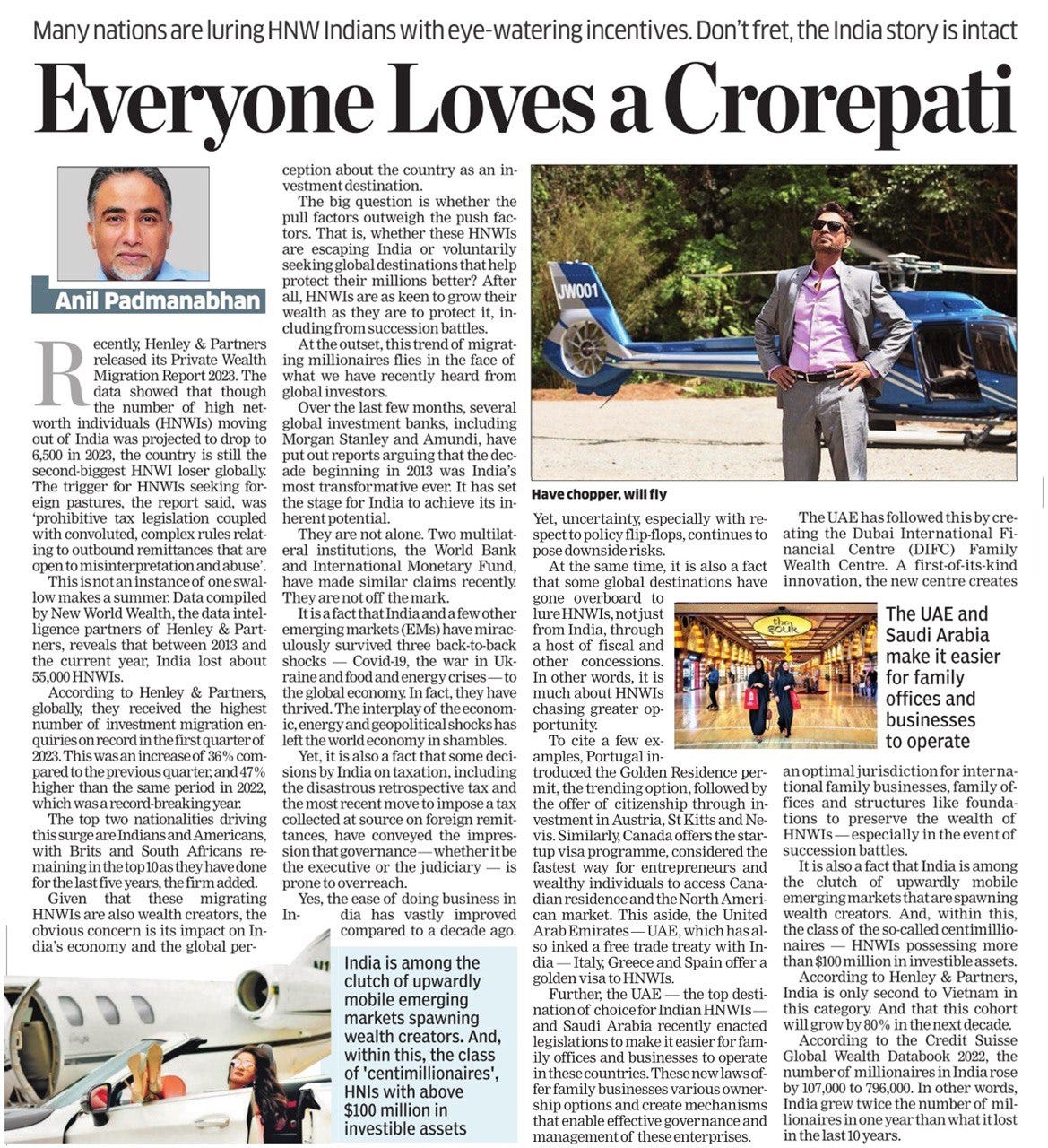GST @6: Still Counting
The sixth anniversary of 'One Nation, One Tax' is as much a cause for celebration as it is for introspection. EPISODE #132
Dear Reader,
A very Happy Monday to you
On 1 July, India will celebrate the sixth anniversary of the Goods and Services Tax (GST)—by far the most important tax reform in modern India, which transformed the country into one economic entity.
The good news is that GST revenues have stabilised at an impressive level. However, six years down the line, there is also cause for introspection—reforms, particularly with respect to shrinking the number of tax slabs, is long overdue.
This week I dwell on the good and the not-so-good about GST. The latter could be a dampener with respect to ease of doing business as the Indian economy matures and readies to become one of the mainstays of the global economy.
Do read and share your feedback. And, please hit the like button if the piece resonated with you.
The cover picture is sourced from Unsplash and taken by Nina Luong.
A big shoutout to Rajit, Monica, Gautam, Premasundaran, Aashish and Vandana for your informed responses, kind appreciation and amplification of last week’s column. Once again, grateful for the conversation initiated by all you readers. Gratitude also to all those who responded on Twitter and Linkedin.
Unfortunately, Twitter has shut down amplification of Substack links and content—perils of social media monopolies operating in a walled garden framework. I would be grateful therefore if you could spread the word. Nothing to beat the word of mouth.
Reader participation and amplification is key to growing this newsletter community. And, many thanks to readers who hit the like button😊.
One Nation, One Tax
On Saturday, India logged the sixth anniversary of its tryst with the Goods and Services Tax (GST).
By any yardstick it is no mean achievement. I am citing only a few examples to argue my case:
Collapsing 36 tax jurisdictions in the country into one tax;
Subsuming 17 taxes and 13 cesses levied by the union and state governments;
Doubling the number of GST registered tax payers to 1.40 crore;
Ensuring consensus in all but one of the 48 meetings of the GST Council (the apex body made up of the union and state governments guiding this indirect tax regime)
You may recall that the idea of GST was first mooted in 2000 by the then National Democratic Alliance regime led by Prime Minister Atal Bihari Vajpayee.
It took 17 years to be productionised. And, in this due tribute should be accorded to the late finance minister Arun Jaitley, who nudged, cajoled and prodded every state finance minister, regardless of their political affiliation, to generate bipartisan consensus on this marquee tax reform.
India’s most audacious tax reform is entering a crucial phase. It has dodged several curve balls—including, the onset of the once in a century covid-19 pandemic which brought economic activity in India and the world to an abrupt halt—belied initial fears about revenues and skirted deep political differences.
Now, there is a need to consolidate these gains to take GST to the next level.
Fears Belied
When the GST was being put together, two fears dogged every state FM on the GST Security Council.
Firstly, the idea of one nation, one tax meant that the states had to give up their right to tax.
Secondly, the states were very uneasy about the impact of an untested indirect tax model on the exchequer. If revenues did not pan out as forecast, then they would be staring at an unprecedented fiscal crisis.
Under the pre-GST regime the centre would tax manufacturing and the states would tax the sales of these goods. GST entailed a big pivot towards consumption. Production heavy states like Tamil Nadu, Maharashtra, Karnataka were naturally worried about potential revenue losses.
Both these fears were legit.
Jaitley resolved this twin challenge through what came to be called the “grand bargain”. The states gave up their individual sovereignty to tax sale of goods and in return the union government committed to share revenues accruing from the taxation of services—prior to GST this was the sole domain of the centre.
To assuage their fears of revenue losses, the centre guaranteed an annual growth of 14% in revenues for the first five years. Any shortfall would be made up by the union government.
At the same time, the GST Council spooked by the fear of revenue losses, preferred to play cautious and opted for four (5%, 12%, 18% and 28%) tax slabs, instead of fewer slabs, and also settled for higher rates. Almost 70% of the products fell into the slab of 18% , implying an average rate higher than what was desired.
Eventually, all the commodities, with the exception of alcohol and fuel, were brought under the purview of GST. Despite this, revenues only grew from strength to strength. The graphic above suggests that they are now testing a new normal of around Rs1.60 lakh crore per month.
Pooling of Sovereignties
GST was made possible with every stakeholder in the GST Council willing to make a sacrifice with respect to their respective taxation powers. This pooling of sovereignties is the single biggest example of cooperative federalism in the recent era. This was a term first coined by Haseeb Drabu, the former finance minister of Jammu and Kashmir (and also the guest for this Thursday’s episode of Capital Calculus on StratNews Global).
In an interview granted to Mint in November 2017, months after the launch of GST, and conducted by a colleague and me, Arvind Subramanian, the former chief economic advisor, said:
“One hundred percent, that (GST) is a great development.
If you step back and look at GST as an instrument of cooperative federalism, I think it is an astonishing institutional achievement for which the finance minister deserves enormous credit. Both for the constitutional amendment bill and then running the GST Council, all done through consensus; this is something that people don’t realize enough.
But the lesson for us is that what we have shown can happen in the area of tax, should happen in every other area of development—water, agriculture, irrigation, so many things where you need cooperative federalism.
I think that is where we have to be headed next. I believe that the future of India lies in the virulent spread of cooperative and competitive federalism, with GST as the harbinger.”
Looking back with the benefit of hindsight, Subramanian was right.
The GST Council is a terrific example of how, when the situation demands, the country’s political parties are able to set aside their political differences for national good. The near hundred percent consensus in 49 meetings of the GST Council is ample testimony.
Gabbar Singh Tax
The fly in the ointment of this feel good story about cooperative federalism though is that political parties tend to speak in a different tune outside the confines of the Council’s meetings.
In the most glaring instance is that of the Congress vice president Rahul Gandhi, who dubbed this as the Gabbar Singh Tax. He was punning on the dreaded dacoit terrorising the fictional town of Ramgarh in the cult Hindi movie Sholay. Gandhi’s argument was that prices were under pressure due to GST.
Often what makes for good politics turns out to be bad economics. While inflation is real, the Congress vice president omitted to mention that his own party was a willing co-founder of GST. But, as we know errors of omissions are par for the course for most politicians.
Unknowingly though Gandhi did put a finger on a festering problem. The initial plan to keep rates high as a safety clause against revenue shortfalls, had clearly outlived its utility. Clearly, this is one item that should top the agenda for change.
A big upside can be that it will ensure better compliance, ensuring that the current buoyancy will not be hit. Not to forget about the welcome relief to the Indian consumer, who has been struggling under the pressure of a covid-19 induced economic shock combined with inflation unleashed by global factors.
Data Mining
A salient feature of GST is that for most parts it is automated. And, this rests on the infrastructure managed by the Goods and Services Tax Network (GSTN).
The above graphic captures a snapshot of the statistics generated by GSTN as on May this year. The scale of the numbers generated is staggering. The ecosystem has spawned a wealth of data about the Indian economy.
Take for example an e-invoice (1,580 crore). Each person supplying goods or services has to generate an invoice on the GSTN—any truck moving beyond 50 km has to generate an e-way bill. The e-invoicing data base covers the taxpayer base who account for 80% of GST revenue.
Further, registration on GSTN, requires the entity to furnish their PAN (or Permanent Account Number for Income Tax). What this does is to connect the direct and the indirect tax networks—shrinking the traditional ways of evading taxes. No wonder, collections on both fronts have been growing over the last few years.
Implicit in this is the growing formalisation of the Indian economy. Even better, once you are in the system, the data generated can be used for a range of things. Yes, scrutiny by tax sleuths is one.
But there is more compelling case: mining the data for leveraging credit.
Enter the Account Aggregator (AA). It enables consent-based monetisation of data, particularly of individuals and small enterprises, who were otherwise invisible to most financial intermediaries.
The AA is very similar to a financial intermediary. However there is a big difference. In this instance the AA oversee the exchange of an individual’s data instead of facilitating money transfers. Their institutional presence protects the privacy of an individual’s data and also mitigates against misuse.
You may recall that I had written about this some time back. Sharing the link, in case you wish to re-read it.
THE UPI MOMENT FOR PERSONAL DATA
Dear Reader, A very Happy Monday to you. Last week India launched yet another ambitious plan to fundamentally alter status quo. This time in the business of individual data. The Account Aggregator (AA) framework, enabling this play, was launched at a virtual event hosted by
Remember that you have 1.40 crore entities (including individuals) registered on GSTN. They are constantly generating data.
Traditional lending is based on collaterals. The AA framework seeks to replace this by scrutinising the flow of data generated by an entity. Hence, the big pivot is from collateral to flow-based lending—typically exploited by the nimble FinTechs.
Typically this data—capturing cash flows in an individual’s bank account for instance—can be mined to offer non-collateral based loans. A great example would be how the over 100 million beneficiaries of the nearly Rs1 trillion rural employment guarantee scheme can use their data, capturing receipts from the government, to avail of loans. At the moment this is not possible since borrowing is presaged on collaterals and the data is not shared.
From Saturday, the GSTN stands integrated with the AA framework—readying India’s rapidly growing digital economy for another big leap. In other words, an entity can choose to share their GSTN data with an AA, who in turn can disclose this to lenders willing to service the entity. Basically, this data is de-risking a transaction.
In the final analysis it is clear that GST has been a game changer for India. Among other things it has forced a mindset reset—particularly with respect to the idea of accepting the rule of law as a way of life. Contrast it with in the manner in which we drive on the roads.
Yet, it is a cup half-full.
Political parties will have to once again bury their differences to bridge the last mile. Not only will this improve ease of doing business, it will also scale the ease of living for the Indian consumer.
Recommended Viewing/Reading
Sharing my latest post on StratNews Global.
This time I take up the report on ‘Private Wealth Migration Report 2023’ released by Henley & Partners last week. It tracks high-net-worth individuals (HNIs) or dollar-millionaires departing from various countries, including India
I interviewed Dominic Volek the Group Head of Private Clients at Henley & Partners, to flesh out the big trends in the report, particularly about India.
In 2023, India will be the second biggest loser of HNIs. About 55,000 dollar-millionaires have departed from India in the last 10 years. Should India need to worry?
The big question is whether the pull factors outweigh the push factors? That is, whether these HNIs are escaping India or voluntarily seeking global destinations that help protect their millions better?
And, is there a net outflow of HNIs from India?
All these questions are answered in this week's episode: The Flight of The Dollar Millionaires.
Do watch and share your thoughts. Sharing the link below:
In a related post I am sharing my latest column in the Economic Times. I had explored the same idea as to whether the departing dollar-millionaires were a cause for worry. Whether the pull factors outweighed the push factors?
Here is the link to the article.
And please find the screenshot below:
Till we meet again next week, stay safe.






Another wonderful article Anil.
I would like to slightly differ with regards to reduction of GST tax rates. One can argue that India at this current stage of development needs to increase % Investment share of GDP and subsequently reduce % consumption share.
Unlike Income Tax and Corporate Tax cuts which relatively increase savings & Investments, a cut in GST would entail increased consumption.
Now unlike the East Asian nations (China, Japan, S. Korea and Taiwan), India is a democracy with budgetary spends more tilted towards consumptions (Freebies, subsidies) and it is only in the last 3-4 years (with PLI, increased Capex on Infra) that the spend is getting little more balanced.
Therefore, there is economic merit in continuing with the present rates. Fiscally speaking it balances the budget but in larger context incentives investment over consumption.
Now politically it might not be prudent but that is different aspect al together.
GST is the best financial move made by the Government in the last 75 years. Critics will always be there, what is making a big difference, is the increasing amount of collection, due to more and more businesses deciding to do away with measures of tax evasion. The now assured amount, every month, is enabling the government to take decisions on planning and spending for infrastructure development in states, Defence purchases, relief measures in areas struck by natural disasters or drought, establishment of educational and medical institutions and keeping contingency funds for distribution of free rations and vaccination during the Covid period and continued support after that. Critics have to keep in mind the growing economic status and consequent respect of the country, in an otherwise dull and gloomy economic environment worldwide. The experts have predicted that India will outpace China in growth, during the next decade. GST is the critical change that has contributed to this situation. An important article Anil, with revealing information, as usual 👏